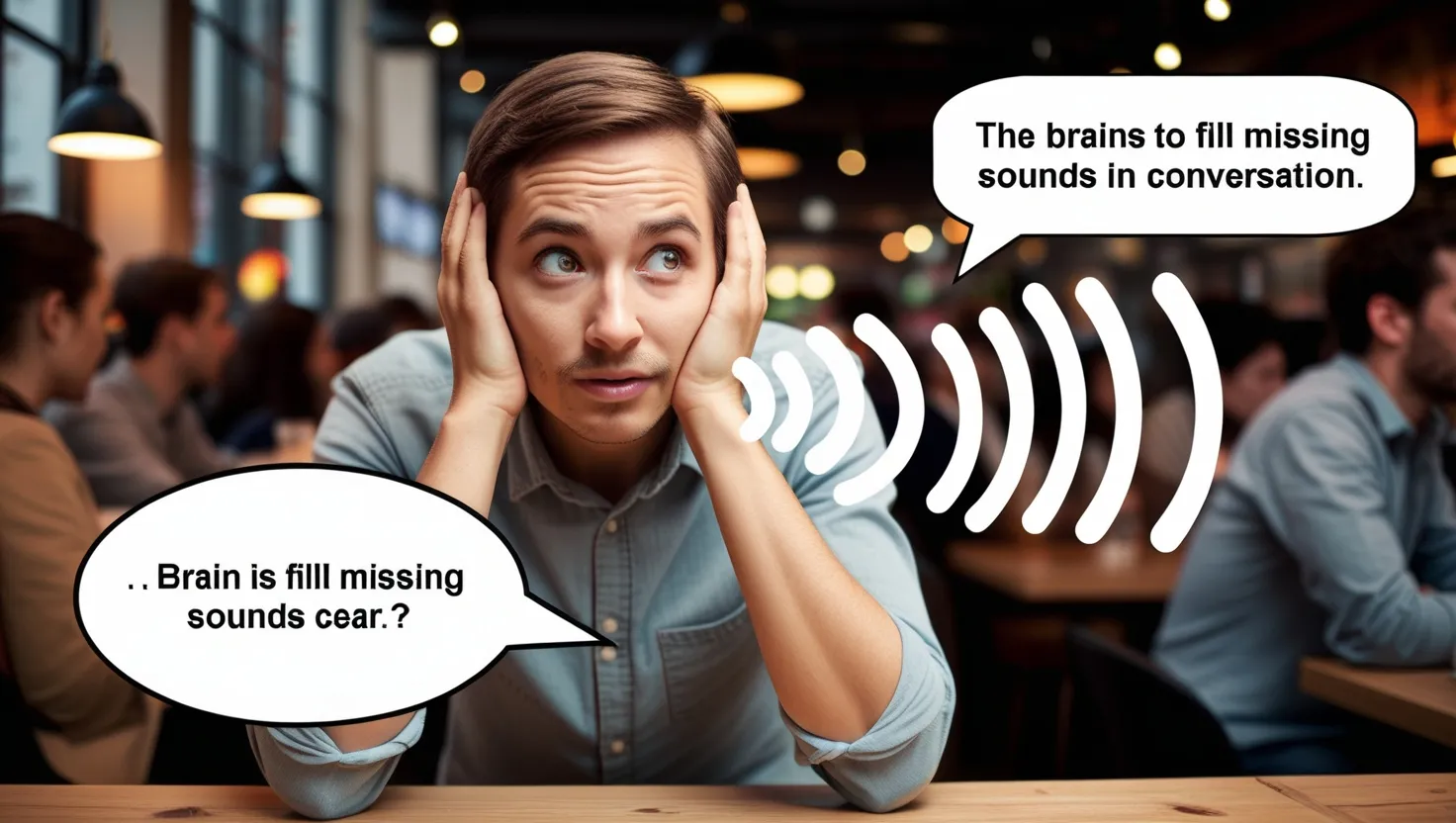Have you ever found yourself in a noisy café, struggling to hear the person across from you, yet somehow managing to understand most of what they’re saying? This isn’t just luck; it’s your brain’s incredible ability to fill in the gaps, a phenomenon known as phonemic restoration.
Phonemic restoration is an auditory illusion where our brains restore missing sounds in speech, making it seem as though we heard the complete word even when parts of it were obscured by noise or other interruptions. This process is so seamless that often, we don’t even realize it’s happening.
To understand how this works, let’s dive into the neuroscience behind it. When we hear speech, our brains use a combination of bottom-up and top-down processing. Bottom-up processing involves the raw acoustic signals our ears pick up, while top-down processing uses our prior knowledge of words and language to make sense of those signals. In noisy environments, the brain relies heavily on this top-down processing to fill in the missing pieces.
Imagine you’re at a busy restaurant and someone says, “Can you pass the sa__?” If the noise masks the “lt” sound, your brain uses the context of the sentence and your knowledge of the word “salt” to restore the missing phonemes. This isn’t just a simple guess; it’s a sophisticated process that involves synchronized activity across large-scale neural networks, particularly in the posterior superior temporal and inferior frontal cortices of the brain[1][2][4].
This ability is not unique to adults; children as young as five can also benefit from phonemic restoration, although their capacity is not as developed as that of adults. At this age, most information is processed through bottom-up mechanisms due to the limited top-down knowledge they have accumulated. However, as they grow, their brains become more adept at using prior knowledge to fill in missing sounds[3].
Phonemic restoration is also influenced by the linguistic context and the listener’s state. For instance, if the missing sound is replaced by a noise that has physical properties similar to the sound it masks, the brain is more likely to restore it. This is why, in conversations with heavy background noise, we often don’t notice the missing phonemes. The brain is constantly making predictions based on the acoustic signal and the semantic context provided by the sentence[2][3][5].
This phenomenon has significant implications for speech recognition technology. By understanding how the human brain restores missing sounds, developers can create more robust speech recognition systems that can perform well even in noisy environments. For example, speech recognition algorithms can be designed to use contextual information to predict and fill in missing phonemes, much like our brains do.
Phonemic restoration also plays a crucial role in how we perceive accents and music. When listening to someone with a strong accent, our brains use phonemic restoration to adjust for the differences in pronunciation, helping us to understand the speaker more clearly. Similarly, in music, our brains fill in missing notes or sounds based on the musical context, enhancing our overall listening experience.
In social interactions, phonemic restoration can be particularly important. In noisy environments like parties or public transportation, being able to understand what others are saying despite the background noise is essential for effective communication. This ability helps us navigate these situations more smoothly, often without even realizing the extent to which our brains are compensating for the missing sounds.
Interestingly, phonemic restoration can be affected by neurodegenerative diseases such as Alzheimer’s and semantic dementia. Research has shown that patients with these conditions may exhibit different patterns of phonemic restoration. For instance, patients with Alzheimer’s disease may show increased phonemic restoration of real words but reduced restoration of pseudowords, indicating a reliance on top-down lexical recognition mechanisms. In contrast, patients with semantic dementia may show reduced phonemic restoration of both real and pseudowords, reflecting a greater reliance on early perceptual mechanisms[1].
This phenomenon is not limited to speech; it has broader implications for how we process and understand our auditory environment. For example, in a reverberation room where sounds echo, the brain’s ability to restore missing phonemes is compromised because the echoes can act as additional noise, making it harder to fill in the gaps[3].
The rate at which sounds are presented also affects phonemic restoration. If the gaps between sounds are too long, the brain’s ability to restore the missing phonemes breaks down, and the listener becomes aware of the interruptions. This highlights the brain’s optimal processing rate for speech, which is crucial for understanding speech in real-time[3].
In addition, the way we process speech in different ears can influence phonemic restoration. In a dichotic listening experiment, where one ear hears a full sentence and the other ear hears the same sentence with a missing phoneme, the brain can still restore the missing sound, demonstrating its remarkable ability to integrate information from both ears to create a coherent auditory experience[3].
While most research on phonemic restoration has been conducted in languages like English and Dutch, it is believed to be a universal phenomenon applicable to all languages. This suggests that the brain’s ability to restore missing sounds is a fundamental aspect of human speech perception, independent of the specific language being spoken[3].
In conclusion, phonemic restoration is a fascinating cognitive process that underscores the brain’s incredible adaptability and resilience in processing language. It’s a testament to how our brains are constantly working behind the scenes to help us make sense of the world around us, even in the most challenging auditory environments. By understanding this phenomenon, we gain insights not only into the neuroscience of speech perception but also into the broader ways in which our brains interact with and interpret the world.






